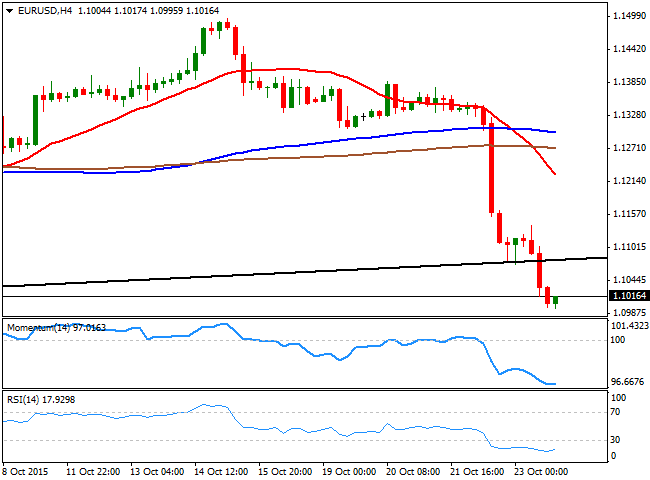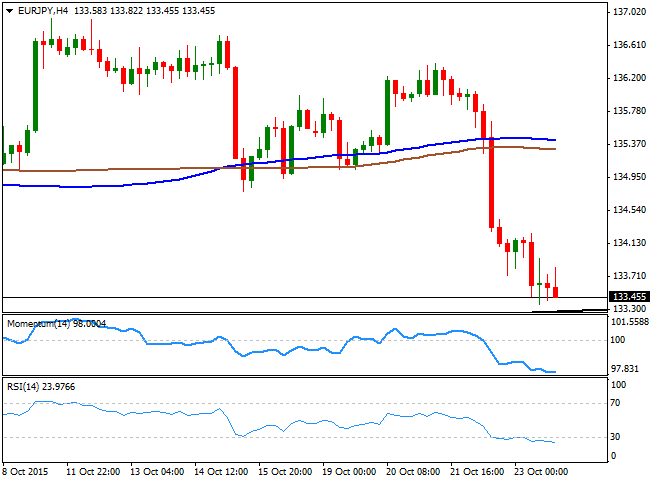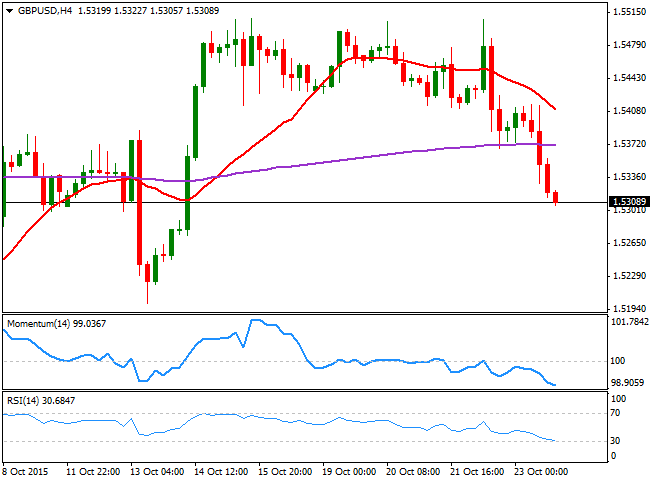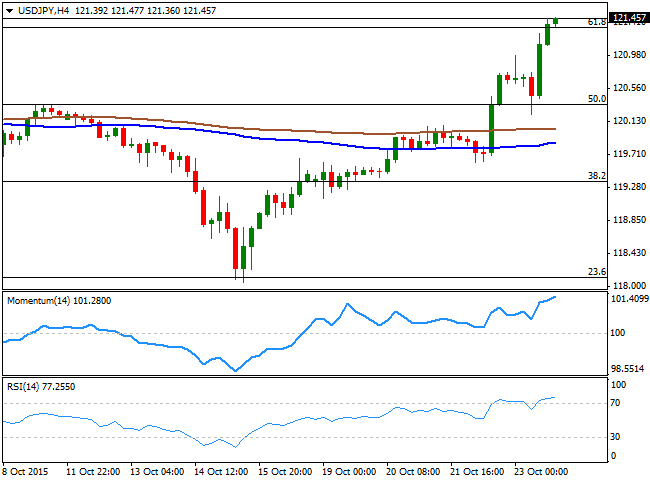EUR/USD Current price: 1.1016
View Live Chart for the EUR/USD

The American dollar extended its advance further on Friday, following the PBoC decision to slash its rates again. The Chinese Central Bank decided to reduce its benchmark lending rate by 25 bps and the reserve requirements ratio for banks by 50 bps during the European morning, the sixth time since November last year the bank cuts rates. The movement seems far from enough to boost the economic recovery, given the result of previous similar decisions, but stocks markets welcomed the second in-a-row announcement of more easing coming from a major Central Bank, and soared, with European equities at fresh 2-month highs and leading to a EUR/USD decline towards the 1.1000 level.
The common currency has been the worst performer this week, already weakened after the ECB announced it may extend its easing program next December. The EUR/USD pair shed around 400 pips in the last two trading days, with almost no upward corrective movements in the middle, falling as low as 1.0995 before bouncing some. The pair has broken below a long term ascendant trend line coming from April low at 1.0519, and the break has strong bearish implications, regardless whatever the US FED announces this week in its Thursday´s policy meeting. As long as upward corrective movements meet selling interest around 1.1120, the downside remains favored. Technically, the daily chart shows that the pair is currently below its moving averages, with the 200 DMA converging with the broken trend line around 1.1120, the mentioned critical resistance, whilst the technical indicators maintain their strong bearish slopes below their mid-lines. In the 4 hours chart, the technical indicators have lost their bearish potential, but remain in extreme oversold readings, far from suggesting the pair may correct higher. Renewed selling interest below 1.1000, should lead to a continued decline down to 1.0920 this Monday, with the ultimate bearish target for this week at 1.0840.
Support levels: 1.1000 1.0960 1.0920
Resistance levels: 1.1045 1.1080 1.1120
EUR/JPY Current price: 133.45
View Live Chart for the EUR/JPY
The EUR/JPY pair fell down to 133.36, weighed by the EUR self weakness, and despite the Japanese Yen eased also against most of its rivals. The pair has stalled its decline a few pips above the base of the huge daily symmetrical triangle that has determinate the trading range ever since late April, and has posted so far a shallow decline, increasing the risk of further long term declines. The daily chart shows that the price is back below the 100 and 200 SMAs that anyway continue to lack directional strength, whilst the trend line comes at 133.20 for this Monday, and the technical indicators present limited bearish slopes below their mid-lines. In the 4 hours chart, however, the bearish momentum remains firm in place, with the technical indicators heading south, despite being in extreme oversold levels, while the 100 and 200 SMAs, remain in a tight range 20 pips range and with no directional strength in the 135.30/50 region. A downward acceleration below the mentioned 133.20 level, also September 23rd daily low, should lead to a continued decline down to 132.25, September monthly low.
Support levels: 133.20 132.65 132.25
Resistance levels: 133.80 134.40 134.95
GBP/USD Current price: 1.5308
View Live Chart for the GPB/USD
The British pound gave back all of its recent gains against the greenback, falling down to 1.5305 last Friday, a level not seen since October 14th. Despite the UK macroeconomic data continued reflecting a steady growth in the kingdom, the Pound capitulated to dollar's demand. The UK will release its third quarter preliminary GDP readings next Tuesday, expected at 0.6% from the previous reading of 0.7%, and if the result misses expectations, could lead to further declines in the GBP. Technically, the daily chart points to further declines ahead, given that the pair broke below its 20 SMA, whilst the technical indicators are crossing their mid-lines with a sharp bearish slope. Shorter term, the 4 hours chart also presents a strong bearish tone, given that the price has extended well below a bearish 20 SMA, and even below its 200 EMA, whilst the technical indicators maintain their strong negative slopes well below their mid-lines.
Support levels: 1.5285 1.5250 1.5210
Resistance levels: 1.5330 1.5370 1.5415
USD/JPY Current price: 121.45
View Live Chart for the USD/JPY
The USD/JPY pair closed at its highest since August 30th, rallying up to 121.47 on Friday. The advance was supported by the strong upward momentum in worldwide stocks, but also on speculation the Bank of Japan will extend its economic facilities in the meeting it will have this week. Japanese inflation remains well below the 2.0% target, and a more aggressive monetary policy stance has been on the table for over a month already, moreover, as the Central Bank will release this time its semi-annual outlook on the economy. The pair has advanced steadily during the past two weeks, and the rally stalled around its 200 DMA, although generally speaking the technical picture is quite bullish in the daily chart, as the technical indicators present strong bullish slopes well above their mid-lines. The 100 DMA stands at 121.70, providing an immediate resistance for the upcoming sessions. Shorter term, and according to the 4 hours chart, the bullish potential is also firm in place, as the Momentum indicator continues heading north, despite being in extreme overbought levels, whilst the RSI indicator consolidates around 77.
Support levels: 121.35 121.00 120.65
Resistance levels: 121.70 122.10 122.45
AUD/USD Current price: 0.7208
View Live Chart for the AUD/USD
The AUD/USD closed in the red for a second week in-a-row, although the decline has been limited, as the Aussie got a boost from Chinese's Central Bank easing decision. The pair jumped to an intraday high of 0.7295 on Friday, but strong selling interest continued to cap rallies on approaches to the 0.7300 figure, leading to a 100 pips decline afterwards. Having closed near its low of the week of 0.7181, the antipodean currency was also weighed by a decline in commodities, particularly precious metals. Technically, the daily chart shows that the price is a few pips below a still bullish 20 SMA, although the Momentum indicator has turned sharply lower and is about to cross its 100 level towards the downside, whilst the RSI indicator also heads south around 50, anticipating some further declines on a break below the mentioned 2-week low. In the 4 hours chart, the price is holding above a horizontal 200 EMA, but below a bearish 20 SMA, whilst the technical indicators lack directional strength, albeit the RSI indicator stands around 42, increasing the risk of a downward continuation.
Support levels: 0.7180 0.7135 0.7100
Resistance levels: 0.7240 0.7290 0.7335
Information on these pages contains forward-looking statements that involve risks and uncertainties. Markets and instruments profiled on this page are for informational purposes only and should not in any way come across as a recommendation to buy or sell in these assets. You should do your own thorough research before making any investment decisions. FXStreet does not in any way guarantee that this information is free from mistakes, errors, or material misstatements. It also does not guarantee that this information is of a timely nature. Investing in Open Markets involves a great deal of risk, including the loss of all or a portion of your investment, as well as emotional distress. All risks, losses and costs associated with investing, including total loss of principal, are your responsibility. The views and opinions expressed in this article are those of the authors and do not necessarily reflect the official policy or position of FXStreet nor its advertisers. The author will not be held responsible for information that is found at the end of links posted on this page.
If not otherwise explicitly mentioned in the body of the article, at the time of writing, the author has no position in any stock mentioned in this article and no business relationship with any company mentioned. The author has not received compensation for writing this article, other than from FXStreet.
FXStreet and the author do not provide personalized recommendations. The author makes no representations as to the accuracy, completeness, or suitability of this information. FXStreet and the author will not be liable for any errors, omissions or any losses, injuries or damages arising from this information and its display or use. Errors and omissions excepted.
The author and FXStreet are not registered investment advisors and nothing in this article is intended to be investment advice.
Recommended Content
Editors’ Picks

EUR/USD holds near 1.0300 as traders await US NFP
EUR/USD trades in a tight channel at around 1.0300 in the European session on Friday. However, concerns over US President-elect Trump's policies and hawkish Fed expectations keep the US Dollar afloat ahead of the Nonfarm Payrolls data, capping the pair's upside.

GBP/USD struggles to stay above 1.2300, eyes on US jobs report
GBP/USD finds it difficult to gather recovery momentum after rising above 1.2300 earlier in the day. The pair remains vulnerable amid persistent US Dollar strength and the UK bond market turmoil. The focus now shifts to the US labor market data for fresh directives.

Gold climbs to fresh multi-week high above $2,680 ahead of US NFP
Gold price (XAU/USD) gains some follow-through positive traction for the fourth consecutive day and trades at its highest level in nearly a month above $2,680. Market focus shifts to US labor market data, which will feature Nonfarm Payrolls and wage inflation figures.

Nonfarm Payrolls forecast: US December job gains set to decline sharply from November
US Nonfarm Payrolls are expected to rise by 160K in December after jumping by 227K in November. US jobs data is set to rock the US Dollar after hawkish Fed Minutes published on Wednesday.

How to trade NFP, one of the most volatile events Premium
NFP is the acronym for Nonfarm Payrolls, arguably the most important economic data release in the world. The indicator, which provides a comprehensive snapshot of the health of the US labor market, is typically published on the first Friday of each month.

Best Forex Brokers with Low Spreads
VERIFIED Low spreads are crucial for reducing trading costs. Explore top Forex brokers offering competitive spreads and high leverage. Compare options for EUR/USD, GBP/USD, USD/JPY, and Gold.